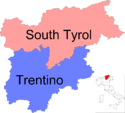Flag of Trentino-Alto Adige/Südtirol
 | |
| Proportion | 2:3 |
|---|---|
| Adopted | June 12 1975 |
| Design | A horizontal bicolour of white and blue, with the coat of arms of Trentino-South Tyrol superimposed on top |
The flag of Trentino-Alto Adige consists of a coat of arms, containing two eagles of San Wenceslao (Trentino) and two Tyrolean red eagles (Alto Adige), historical symbols of the two provinces, which stand out against a white and blue background. The shape of the flag is a rectangle with a framed heraldic shield on it. Like other flags, the flag of Trentino-Alto Adige is also inspired, albeit differently, by the French flag introduced with the revolution of 1789. When Napoleon's army crossed Italy, starting from March 1796, flags of tricolor style they were adopted both by the various newborn Jacobin republics and by the military units that supported the French army. In the Alpine region, however, sketches of the two-tone we know well today began to emerge. Trentino-Alto Adige has been a region with a special statute since 1948. The two parts that make it up, the Province of Trento and the Province of Bolzano, in turn constitute two provinces with particular prerogatives of autonomy defined in 1972. The white-blue flag, in use (limited) since 1995, takes up the characteristics of the banner, including the shield with quartered eagles from the province of Trento (1st and 4th) and that of Bolzano (2nd and 3rd). White and blue are the colors on which the coats of arms of Trento and Bolzano respectively were worn in ancient times. It has never been legally defined, unlike the coat of arms and the banner, approved on 17 September 1982 and approved by presidential decree of 21 March 1983.
History[]
The flag has no ancient origins, it most likely derives from the French tricolor, with the colors in the flag and in the coat of arms. With the Austrian reoccupation of the Habsburgs, completed in 1814 by Bellegarde against Eugenio di Beauharnais, the Trentino-Altoatesino bicolor was completely abandoned, as a symbol of the past Napoleonic regime. In fact, he certainly identified himself with it. With regard to Trentino, the first public signal of Austrian intentions to dissolve the army of the Kingdom of Italy consisted in the prohibition, issued by Bellegarde on 13 June 1814, to wear tricolor cockades, evidently very widespread. With certainty, Francis II and Bellegarde were quite convinced that no other ties had matured in the meantime. There are various versions of the exact origin of the flag. One version claims that the flag was created after the First World War, while the other says that it was all a coincidence, mainly because it was thought that such different ethnic groups, such as the Austrian and the Italian, had never shared a territory. The flag of Trentino-Alto Adige has ancient origins in terms of its coat of arms. The eagle of St. Wenceslas, making up the coat of arms, was granted by the sovereign John of Luxembourg on 9 August 1339. The rest of the flag is made up of two horizontal bands of blue and white.
The flag is a horizontal bicolour of white and blue, with the coat of arms of the region on top.[1][2]
References[]
- ^
Raeside, Rob (2017-09-04). "Trentino-Alto Adige Region (Italy)". Flags of the World. Retrieved 17 February 2020.
{{cite web}}: CS1 maint: url-status (link) - ^ "Trentino AA". Bandiere Dalvivo. Retrieved 17 February 2020.
{{cite web}}: CS1 maint: url-status (link)
- Flag stubs
- Flags of regions of Italy
- Flags displaying animals
- Flags introduced in 1975
